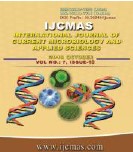


 National Academy of Agricultural Sciences (NAAS)
National Academy of Agricultural Sciences (NAAS)

|
PRINT ISSN : 2319-7692
Online ISSN : 2319-7706 Issues : 12 per year Publisher : Excellent Publishers Email : editorijcmas@gmail.com / submit@ijcmas.com Editor-in-chief: Dr.M.Prakash Index Copernicus ICV 2018: 95.39 NAAS RATING 2020: 5.38 |
The effluent quality of a carbonated soft drink (CSD) company in Owerri and the receiving water body (Nworie River) were determined using standard microbiological and physicochemical methods. Microbial loads showed that total heterotrophic count (THC) ranged from 1.0 × 102 ±0.14 to 3.7 × 105 ±0.53 CFU/ml, total coliform count (TCC) ranged from 0.2 × 101 ±0.19 to 2.9 × 105 ±0.50 CFU/ml and yeast and mould count (Y&MC) ranged from 1.1 × 102 ±0.1 to 2.1 × 104 ±0.93 CFU/ml (p<0.05). Six (6) bacterial isolates were identified to include Pseudomonas species, Bacillus species, Staphylococcus species, Escherichia coli, Flavobacterium species, and Azotobacter species, while six (6) fungal isolates were identified to include Aspergillus species, Penicillium species, Acremonium species, Rhodotorula species, Saccharomyces cerevisiae, and Candida species. Physicochemical results obtained in this study showed a pattern (p<0.05) with higher values recorded in the influent and least values in the effluent samples, while in the receiving water body, higher values were recorded in the discharge point, followed by downstream and least values in the upstream samples. However, it was discovered that discharges into the same tunnel from neighborhood companies around the industrial site increased the pollution level of the discharged effluent into the river, leaving potential effects on the downstream. Having considered the need for a sustainable water economy with looming water scarcity globally, and associated health hazards with untreated wastewater, there is need for proper monitoring by concerned agencies in ensuring wastewater from industries are treated to meet minimum permissible quality standards to avoid midstream contamination.
 |
 |
 |
 |
 |